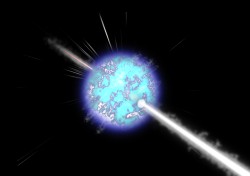High Energy Astrophysics

An artists impression
of a Gamma-Ray Burst
High Energy Astrophysics covers the most powerful phenomena in the Universe; topics such as Black Holes, Gamma Ray Bursts and Active Galactic Nuclei.
Here at the Astrophysics Research Institute we run a selection of life-long learning courses that can be taken by students who do not have any specialist scientific or mathematical background. These courses are taken as part time distance learning courses; you do not need to attend any on-site classes.
The course is split into the following sections:
- Observing the High Energy Universe: How do we detect high-energy radiation from astronomical objects? The technology used to observe the universe both defines the limits of what we can learn and provides a route for constant improvement. But what are the techniques used for High Energy "light", what are the limitations, and how do we get useful measurements from the data?
- High Energy Astrophysics: What do we mean by High Energy Astrophysics? What physical processes are involved in the production of x-rays and gamma rays and how has our understanding of these processes changed?
- Black Holes: What is a black hole and how does one form? What are the physics of these extreme objects, and how similar are stellar black holes to the supermassive ones at the centre of galaxies. What role do black holes play in the formation of Gamma Ray Bursts and high energy astrophysics?
- Active Galactic Nuclei: Active galactic nuclei (AGN) are the centre of active galaxies that have a far greater luminosity than normal galaxies and AGN are some of the strongest sources of electromagnetic radiation in the Universe. The radiation emitted from AGN is the result of accretion of mass by a supermassive black hole at the centre of the galaxy. AGN can also be used as a method of measuring the properties of the Universe in general, and can be used to provide the constraints for current cosmological models.
- Gamma Ray Bursts: Gamma Ray Bursts (GRBs) are short, intense flashes of gamma rays that can last from a few milliseconds to around 100 seconds and arise from the most violent and explosive events in the universe. Discovered in 1967 and remaining a mystery for more than a quarter of a century, these extraordinary events are only just starting to be understood thanks to recent developments in astronomical instrumentation. Fast communication between satellites such as NASA's SWIFT satellite and rapid response ground based robotic telescopes such as the Liverpool Telescope have made it possible to observe and study these short lived phenomena.
The course lasts for five months. You will be expected to produce a two pieces of coursework and take a multiple-choice test over the Internet as part of the course. Overall we expect that you will need to put around 100 hours of time into the course.
